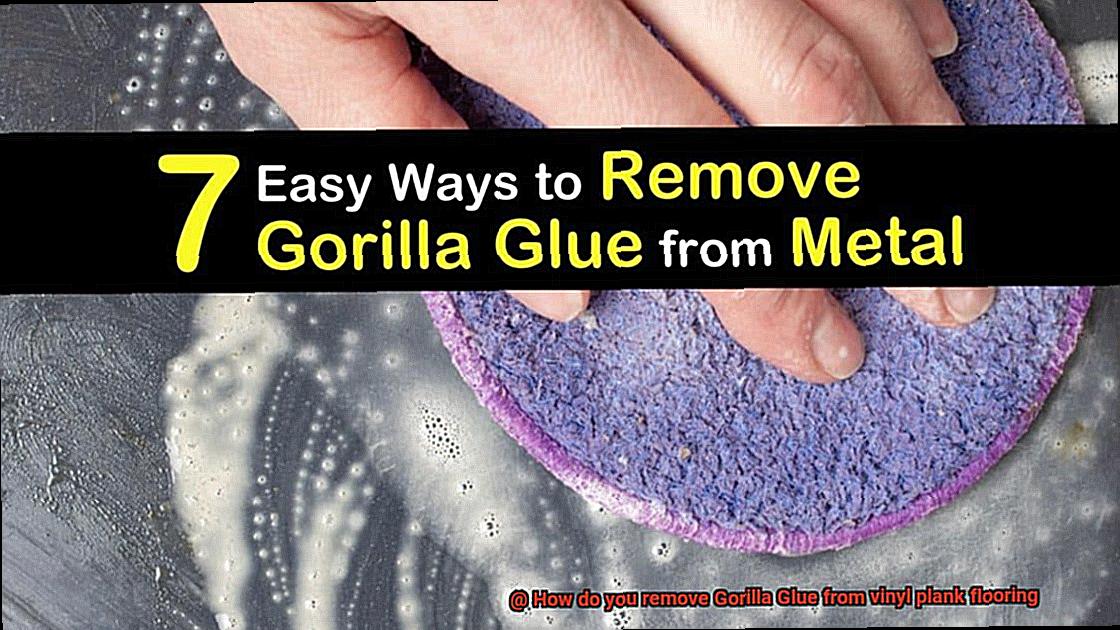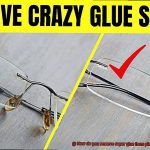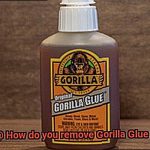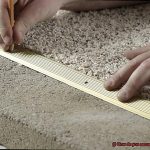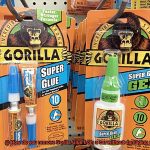Title: Say Goodbye to Gorilla Glue Mishaps: Removing Adhesive from Vinyl Plank Flooring
Introduction:
Contents
- 1 Acting Quickly to Avoid Damage
- 2 Using Acetone to Remove Gorilla Glue from Vinyl Plank Flooring
- 3 Testing Acetone on a Small, Inconspicuous Area
- 4 Applying Acetone and Scraping Away the Softened Glue
- 5 Using Soap and Water Solution for Remaining Glue Residue
- 6 Using White Vinegar to Break Down the Glue
- 7 Utilizing Rubbing Alcohol for Stubborn Stains
- 8 Additional Methods for Removal
- 9 Conclusion
We’ve all been there – a DIY project gone wrong, leaving behind unsightly Gorilla Glue stains on your gorgeous vinyl plank flooring. But fear not. In this blog post, we’ll share the best methods for safely and effectively removing this stubborn adhesive. So let’s dive right in and unstick those troubles.
Method 1: Lukewarm Soak and Scrape
Step 1: Grab a bucket and mix warm water with mild dish soap.
Step 3: Gently scrape away the glue residue using a plastic scraper or soft-bristle brush.
Step 4: Rinse the area with clean water and pat dry with a clean cloth.
Method 2: Vinegar Magic
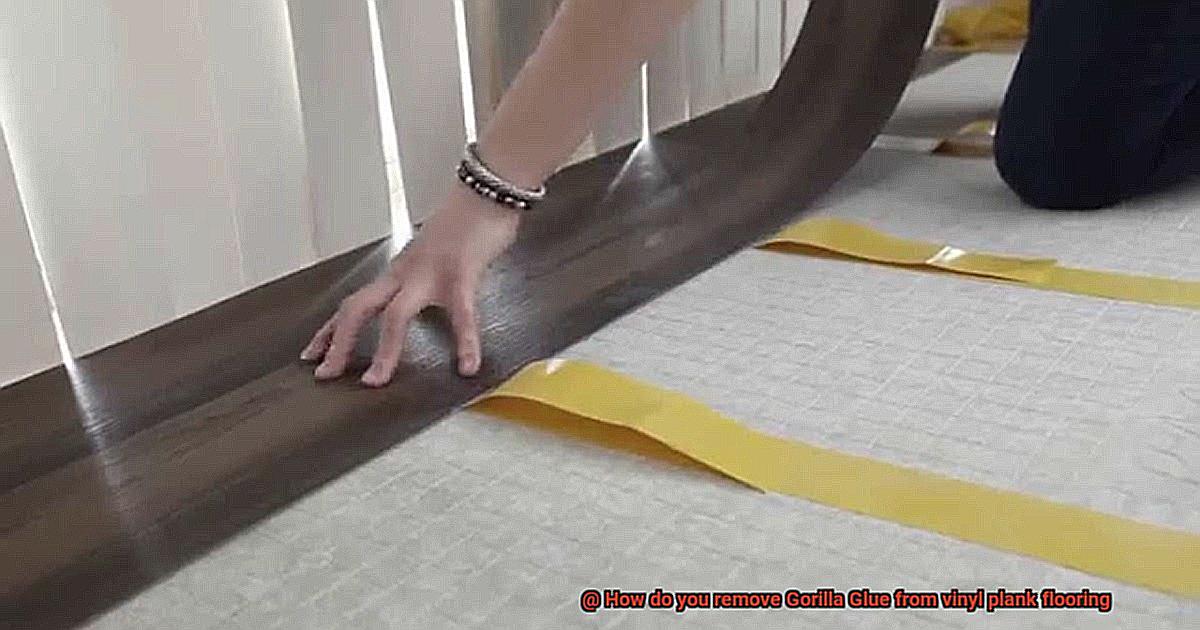
Step 1: Fill a spray bottle with equal parts white vinegar and warm water.
Step 3: Use a plastic scraper or soft-bristle brush to gently scrape away the softened glue.
Step 4: Rinse the area with clean water and dry with a clean cloth.
Method 3: The Ice Approach
Step 1: Grab an ice pack or fill a plastic bag with ice cubes.
Step 2: Place the ice pack or bag directly over the Gorilla Glue stain.
Step 3: Let it sit for about 15 minutes to freeze and harden the glue.
Step 5: Wipe the area clean with a damp cloth.
Method 4: Acetone Channel
Step 1: Make sure the room is well-ventilated and put on some gloves.
Step 3: Gently scrape away the softened glue using a plastic scraper or soft-bristle brush.
Step 4: Rinse the area thoroughly with
Acting Quickly to Avoid Damage
Vinyl plank flooring is loved for its durability and easy maintenance. However, accidents happen, and if you find yourself dealing with Gorilla Glue on your vinyl plank flooring, it’s crucial to act quickly to avoid permanent damage. In this article, we will explore why acting swiftly is important and provide you with effective techniques to safely remove Gorilla Glue without harming your flooring.
Why Acting Quickly Matters:
- Prevents Hardening: Gorilla Glue is notorious for its strong adhesive properties and fast drying time. The longer it sits on your vinyl plank flooring, the harder it becomes to remove. Acting promptly helps prevent the glue from fully hardening and bonding to the surface.
- Minimizes Damage: Vinyl plank flooring can be sensitive to certain cleaning agents or abrasive methods. By acting quickly, you can avoid the need for aggressive scrubbing or using harsh chemicals that may cause discoloration or damage to the flooring.
Effective Techniques for Removing Gorilla Glue:
- Assess the Situation: Determine the size of the glue spill. For small areas, you can attempt removal yourself using household items and gentle cleaning methods. However, for larger spills or if you’re unsure, it’s best to seek professional help.
- Protect Yourself and Surroundings: Wear gloves to shield your hands from chemicals or cleaners. Place towels or plastic sheets around the affected area to prevent further spread of the glue during removal.
- Blot Up Excess Glue: Act quickly by blotting up as much excess glue as possible with a clean cloth or paper towel. Gently press down on the glue to soak up any liquid or semi-liquid portions before they dry and harden.
Use Gentle Cleaning Methods:
- Warm Soapy Water: Mix a few drops of dish soap with warm water in a bucket. Dip a soft cloth into the soapy solution and gently rub it over the glue spot. Allow the soapy water to penetrate and soften the glue before wiping away with a clean cloth.
- Rubbing Alcohol or Nail Polish Remover: Moisten a clean cloth with rubbing alcohol or nail polish remover and dab it onto the glue. These substances help break down the adhesive properties of Gorilla Glue, making it easier to remove. However, test them on an inconspicuous area first to avoid potential damage.
Using Acetone to Remove Gorilla Glue from Vinyl Plank Flooring
Fear not. I’m here to share a tried and true method using acetone to banish that Gorilla Glue from your vinyl plank flooring.
But before we dive into the step-by-step instructions, let’s cover some important points. Acetone is a powerful solvent that effectively dissolves Gorilla Glue. However, it’s always a good idea to test it on a small, inconspicuous area of your flooring first to ensure it won’t cause any damage or discoloration.
Now that we have that covered, here’s what you’ll need for this task:
Gloves: Protect your hands while working with acetone.
Ready? Let’s get started.
Gently dab the affected area with the acetone-soaked cloth or sponge. Avoid rubbing or scrubbing vigorously as this may damage the flooring. Just gently pat and dab at the Gorilla Glue.
Allow the acetone to sit on the glue for a few minutes. This will soften the glue, making it easier to remove.
Once the glue has softened, use a plastic scraper or your fingers (protected with gloves) to gently lift off the glue from the surface of the flooring. Be careful not to scratch or scrape too hard.
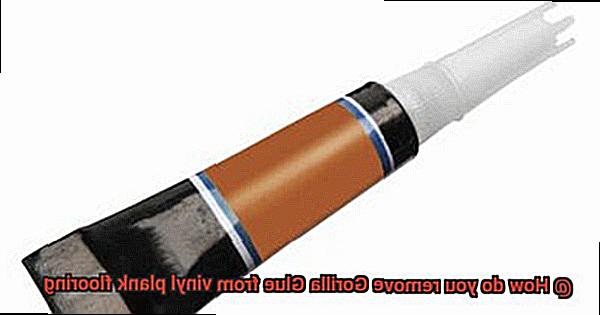
If there are any remnants of Gorilla Glue left after removing the majority of it, repeat the process until all traces of glue are gone. Patience is key here.
After removing the Gorilla Glue, wipe down the area with a clean cloth dampened with water to remove any residue from the acetone.
Finally, dry the area thoroughly to prevent any moisture from damaging the vinyl plank flooring. You can use a clean, dry cloth or even a fan to speed up the drying process.
And voila. Your vinyl plank flooring is now free from the clutches of Gorilla Glue. Remember, safety first. Work in a well-ventilated area and avoid contact with your skin or eyes when handling acetone.
Testing Acetone on a Small, Inconspicuous Area
Oh, the frustration of battling Gorilla Glue on your pristine vinyl plank flooring. But fear not, brave warriors of glue, for I bring you a solution that will banish that stubborn adhesive once and for all. Enter acetone, the mighty solvent that can save the day. However, before charging into battle, it’s crucial to test acetone on a small, inconspicuous area of your vinyl plank flooring to ensure it won’t cause any damage or discoloration. Here’s a step-by-step guide to conducting this essential test.
Step 1: Choose your testing ground
To begin, seek out a hidden or less visible area of your flooring, like under furniture or in a distant corner. This will allow you to gauge the effects of acetone without sacrificing the overall appearance of your floor.
Step 2: Apply the acetone
Using a clean cloth or cotton swab, gently apply a small amount of acetone to your chosen testing area. Be careful not to saturate the cloth or swab – excessive moisture could harm your precious vinyl plank flooring.
Step 3: Observe and wait
Now comes the moment of truth. Watch closely for any signs of discoloration, damage, or adverse effects as the acetone interacts with the vinyl plank flooring. Patience is key here – let the acetone sit on the test area for a few minutes so it can work its magic.
Step 4: Wipe away and inspect
After the brief waiting period, use a clean cloth or paper towel to wipe away the acetone from the test area. Take a good look at the flooring and examine for any noticeable changes in appearance or texture. If everything remains unchanged and there are no adverse reactions, rejoice. It’s a promising sign that acetone is safe to use for removing Gorilla Glue from your vinyl plank flooring.
Applying Acetone and Scraping Away the Softened Glue
Vinyl plank flooring is a beautiful and durable option for your home, but accidents happen, and sometimes you find yourself dealing with stubborn adhesive residue like Gorilla Glue. Fear not. With the right approach and a little help from acetone, you can easily banish those glue remnants and restore the beauty of your flooring. So, grab your cleaning gear and let’s dive into the world of glue removal.
Step 1: Test the Acetone
Before you proceed, it is crucial to test the acetone on a small, inconspicuous area of your vinyl plank flooring. Apply a small amount of acetone on a cloth or sponge and gently dab it onto the glue. Wait for a few minutes and observe for any discoloration or damage. If all looks good, you’re ready to move on.
Step 2: Prepare Your Tools
Gather your supplies – a clean cloth or sponge, a small container to hold the acetone, and a plastic scraper or putty knife. Having these tools at hand will make the process smoother and more efficient.
Step 3: Apply the Acetone
Moisten your cloth or sponge with acetone and gently dab it onto the Gorilla Glue. Allow the acetone to sit on the glue for a few minutes. This will soften the glue, making it easier to remove.
Step 4: Scrape Away the Softened Glue
Using your plastic scraper or putty knife, gently scrape away the softened Gorilla Glue from the vinyl plank flooring. Be cautious not to scratch or damage the surface of your flooring. If needed, repeat this step until all traces of glue have been removed.
Step 5: Clean and Dry
After successfully removing the Gorilla Glue, clean the area with a mild soap solution and warm water to eliminate any residue left by the acetone. Rinse with clean water and dry the vinyl plank flooring thoroughly with a clean towel or allow it to air dry before walking on it again.
Conclusion:
Removing Gorilla Glue from your vinyl plank flooring may seem daunting, but with the right approach and the power of acetone, you can restore your flooring’s pristine appearance. Remember to test the acetone first, use the proper tools, and be patient during the process. Soon enough, your vinyl plank flooring will be glue-free and ready to shine once again.
Using Soap and Water Solution for Remaining Glue Residue
In this fascinating guide, we will walk you through the steps of using a soap and water solution to bid farewell to that stubborn glue residue. So, roll up your sleeves, grab your cleaning supplies, and let’s embark on this exciting journey together.
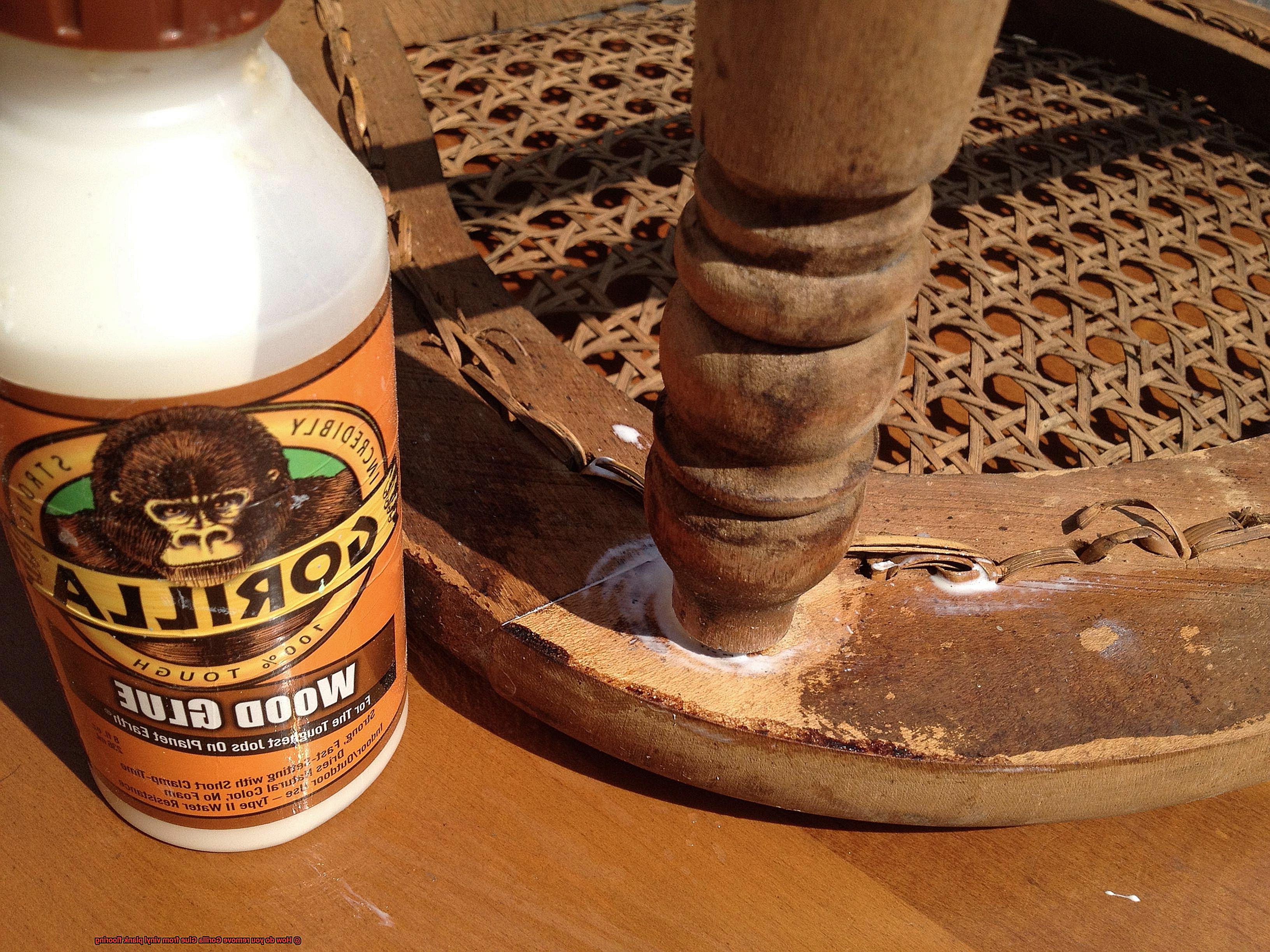
Step 1: Ensure Water Resistance:
Before delving into the cleaning process, it is crucial to ascertain whether your vinyl plank flooring is water-resistant. Consult the manufacturer’s instructions or conduct a small test in an inconspicuous area to avoid any potential damage.
Step 2: Prepare the Soap and Water Solution:
In a bucket or spray bottle, combine warm water with a few drops of mild dish soap or liquid detergent. This gentle yet effective solution will help break down the glue residue without causing harm to your precious flooring.
Step 3: Scrub and Soak:
Dip a soft cloth or sponge into the soapy water solution and gently scrub the glue residue on your vinyl plank flooring. Alternatively, you can directly spray the solution onto the affected area. Allow the solution to work its magic for a few minutes, allowing it time to loosen up the residue.
Step 4: Scrape It Off:
Equip yourself with a plastic scraper or a plastic spatula, and carefully scrape off the softened glue residue from the flooring. Exercise caution to prevent any scratches or damage to the surface. If needed, repeat steps 3 and 4 until every last trace of glue residue is eliminated.
Step 5: Rinse and Dry:
After successfully bidding farewell to the glue residue, rinse the area with clean water to remove any lingering soap residue. Employ a clean cloth or sponge dampened with water to wipe away any excess soap. Finally, ensure the area is thoroughly dried either by using a clean towel or allowing it to air dry completely before resuming normal use of the vinyl plank flooring.
Conclusion:
Congratulations. You have successfully conquered the battle against glue residue on your vinyl plank flooring. By following these simple steps and utilizing a soap and water solution, you can restore your flooring’s pristine appearance without breaking a sweat. Always remember to test any cleaning solution on a small, inconspicuous area and consult the manufacturer’s instructions when dealing with stronger adhesives. Now, sit back, relax, and revel in the beauty of your glue-free vinyl plank flooring.
Using White Vinegar to Break Down the Glue
Using White Vinegar to Break Down the Glue
Vinyl plank flooring is a popular choice for many homeowners due to its durability and easy maintenance. However, accidents happen, and sometimes that strong adhesive known as Gorilla Glue finds its way onto your beautiful flooring. But fear not. We have a secret weapon in our cleaning arsenal that will help you banish that stubborn glue – white vinegar.
White vinegar is a versatile household item that has been used for centuries for various cleaning purposes. Its acidic properties make it an effective solution for breaking down adhesives like Gorilla Glue. Here’s how you can use white vinegar to save the day:
First, dilute the vinegar by mixing one part vinegar with three parts water in a spray bottle. This will ensure that the vinegar is not too harsh on your vinyl flooring. Next, directly spray the diluted vinegar solution onto the affected area where the Gorilla Glue is located. Be generous with your spraying, making sure to cover the entire glue stain. Allow the vinegar to sit on the glue for several minutes to allow it to penetrate and break down the adhesive.
After giving the vinegar time to work its magic, grab a scraper or a plastic putty knife and gently scrape away the softened glue. Take care not to scratch or damage the vinyl flooring while doing so. If there are any stubborn residue or remnants of the glue left behind, repeat the process of spraying with vinegar and scraping until all of the glue has been removed. Patience is key here, as some adhesives may require multiple attempts.
Once all of the glue has been successfully removed, clean the area with a mild detergent or soap and water to remove any leftover vinegar residue. This final step will ensure that your vinyl flooring stays in pristine condition.
It’s important to note that while white vinegar is generally safe to use on vinyl flooring, it’s always recommended to test it on a small, inconspicuous area first to ensure there are no adverse reactions or damage. Additionally, some Gorilla Glue may be particularly stubborn or difficult to remove, requiring the use of additional methods or products in combination with white vinegar.
Utilizing Rubbing Alcohol for Stubborn Stains
Vinyl plank flooring is beloved for its durability and easy maintenance, but dealing with stubborn stains like Gorilla Glue can be a nightmare. Luckily, rubbing alcohol can come to the rescue and restore the pristine look of your floors. In this post, we will guide you through the step-by-step process of effectively utilizing rubbing alcohol to remove those tough glue stains.
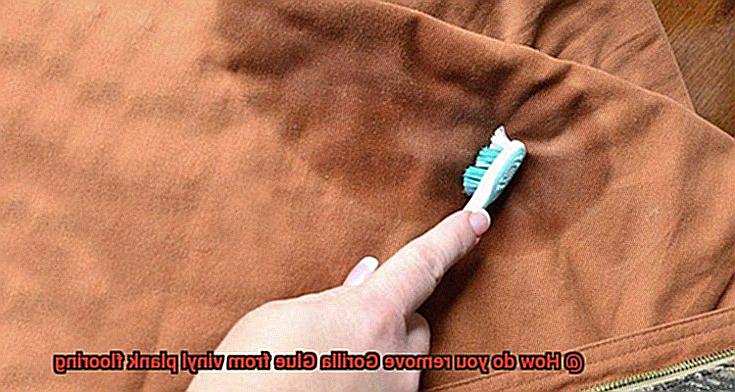
Step 1: Test a small area:
Before diving into stain removal, it’s crucial to test rubbing alcohol on a small, inconspicuous spot of your vinyl plank flooring. This ensures no damage or discoloration occurs.
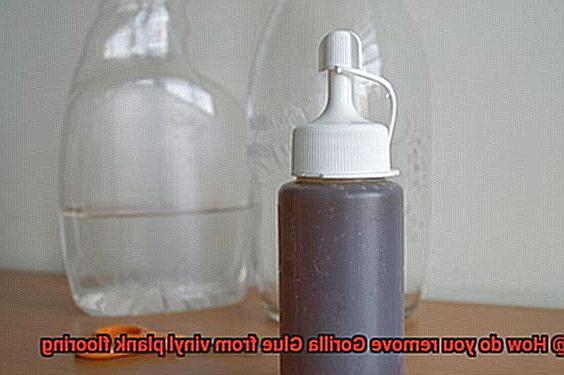
Step 2: Apply rubbing alcohol:
Apply a small amount of rubbing alcohol directly onto the Gorilla Glue stain. Allow it to sit for a few minutes, letting it penetrate the glue.
Step 3: Gently rub the stain:
Using a clean cloth or sponge, gently rub the stain in circular motions. The rubbing alcohol works its magic by breaking down the glue, making it easier to remove. For stubborn stains, consider using a soft-bristle brush for gentle scrubbing. Avoid stiff brushes or excessive force, as they may damage your flooring.
Step 4: Clean up:
After successfully removing the Gorilla Glue stain, thoroughly clean the area. Use warm water and mild soap to remove any residue from the rubbing alcohol. Rinse well and pat dry with a clean towel.
Step 5: Additional considerations:
While rubbing alcohol generally removes Gorilla Glue stains from vinyl plank flooring, it may not work on all types of glue or flooring. If difficulties arise or concerns persist, consult a professional or contact the manufacturer for further guidance.
Additional Methods for Removal
However, when Gorilla Glue clings stubbornly to this resilient surface, it can feel like an uphill battle. In this blog post, we will explore some additional methods for removing Gorilla Glue from vinyl plank flooring. From harnessing the power of heat to employing solvents and commercial adhesive removers, we’ve got you covered.
Heat it up:
To soften the glue, try using a hairdryer or heat gun on a low setting. Gradually increase the heat if needed, but use caution to prevent damage to the vinyl plank flooring. Let the glue melt and become more pliable, making it easier to scrape off.
Rubbing alcohol or acetone:
Soak a cloth or sponge in rubbing alcohol or acetone and gently rub it onto the glue. Allow the solvent to penetrate the adhesive for a few minutes before peeling off the softened glue with a plastic scraper or your fingers. Test the solvent on a small area first to ensure it won’t cause damage or discoloration.
Commercial adhesive removers:
If other methods fail, consider using commercially available adhesive removers designed specifically for tough adhesives. Follow the manufacturer’s instructions carefully, applying the remover onto a cloth or sponge and allowing it to sit before attempting to remove the glue.
Remember:
- Patience and persistence are crucial when removing Gorilla Glue from vinyl plank flooring.
- Avoid excessive force that could damage the flooring.
- Wear gloves and ensure proper ventilation when working with solvents or adhesive removers.
Conclusion:
Removing Gorilla Glue from vinyl plank flooring may be challenging, but with these additional methods at your disposal, you can tackle even the most stubborn stains. Whether you choose to use heat, solvents, or commercial adhesive removers, always prioritize safety and test any products on a small area before proceeding. With patience and the right techniques, you’ll restore your vinyl plank flooring to its flawless glory.
Research:
In this section, we will explore some additional methods for removing Gorilla Glue from vinyl plank flooring. While the previous section discussed the primary methods, there are a few alternative approaches that can also be effective in tackling this stubborn adhesive.
One method to consider is utilizing heat. By using a hairdryer or heat gun on a low setting, you can soften the glue and make it more pliable for easy removal. Start with a low heat setting and gradually increase if necessary. Be cautious not to damage the vinyl plank flooring with excessive heat.
QYmZSDjLQ9A” >
Also Read: Will WD-40 remove Gorilla Glue?
Conclusion
Removing Gorilla Glue from vinyl plank flooring can be a challenging task, but with the right approach, it is possible to restore your floor’s pristine condition. Here are some effective methods you can try:
Begin by gently scraping off any excess glue using a plastic scraper or a credit card. Be careful not to scratch the surface of the vinyl plank.
Next, dampen a cloth with warm water and soap, and gently rub the affected area in circular motions. This will help soften the glue and make it easier to remove.
If the glue persists, you can try using acetone or nail polish remover. Apply a small amount on a clean cloth and carefully dab the glue until it starts to dissolve.
For stubborn glue stains, you may need to use a commercial adhesive remover specifically designed for vinyl flooring. Follow the manufacturer’s instructions and test it on a small, inconspicuous area first to ensure it doesn’t damage your floor.
Once all traces of Gorilla Glue have been removed, rinse the area thoroughly with clean water to remove any residue from the cleaning agents.
Remember to always exercise caution when working with chemicals and test any products on an inconspicuous area before applying them to larger sections of your vinyl plank flooring.

